Contents
- A background on the nation’s slow growth
- Major metro areas show greatest growth downturns
- Pandemic year out-migration impacted select urban cores
- Post-pandemic urban population growth
There has been much speculation about the impact that COVID-19 has had on population changes across the country since the pandemic began in the early part of 2020. Most of this discussion has been focused on the ways COVID-19 has affected moves across the US—from large metropolitan areas to smaller ones, and from cities to suburbs—largely reflecting a “flight from density” and greater capabilities to telecommute.
Yet, there are other demographic components that have been impacted by the pandemic and hold important consequences for these shifts—a marked downturn in immigration to the U.S. from abroad, along with well documented reductions in the number of births and rising number of deaths . Changes in each of these components since the pandemic began have affected population growth in much of the U.S., especially in large metropolitan areas and their urban core areas.
The analysis below examines annual population changes for metropolitan area and core counties resulting from each of these demographic components based on recently released Census Bureau data showing annual population changes from July 1, 2019 to July 1, 2020.1 As such, it provides the first comprehensive assessment of how domestic migration, international migration, and natural increase (the excess of births over deaths) impacted area population change during the year that the pandemic hit.
The results show that each of these demographic components continued and often exacerbated trends that were already evident before the pandemic. Many large coastal and midwestern metropolitan areas and their urban core counties registered their lowest population gains (or greatest declines) in a decade due to this combination of demographic components: accelerated domestic out-migration, lower immigration from abroad, and a decline in the excess of births over deaths. Because each of these components have different pandemic and non-pandemic related explanations, predicting post-pandemic population shifts is not a straightforward exercise.
A background on the nation’s slow growth
Any examination of population changes within the U.S. needs to first recognize that they were occurring in the context of a national population growth slowdown that was evident before the pandemic occurred. The demographic components of national growth are, respectively, immigration from abroad, as well as births and deaths to U.S. residents.

Immigration is subject to economic forces, as well as to U.S. immigration policy and enforcement practices. As Figure 1 shows, the immigration levels began to plummet in 2017-18, coincident with restrictive policies enacted by the Trump administration, and dipped further to a low of just 477,000 in 2019-20 because of further pandemic year limits. This was the smallest annual gain of international migrants in at least 30 years.
The nation’s natural increase (births minus deaths) component for 2019-20 of 677,000 represents a substantial dip from 921,000 and 996,000 in the two previous years and levels of well above 1 million annually in years prior (download Table A). This clearly reflects a sharp rise in deaths due to COVID-19, which has continued through 2021. At the same time, the downsizing of births for 2019-20 represents childbearing decisions made before the pandemic began—a pattern consistent with delayed fertility of young adult women exacerbated by the previous decade’s Great Recession. The lower birth and higher death totals for 2019-20 were notable for the nation and most areas within it.
Together, low immigration, more deaths and fewer births led to a national 2019-21 growth rate of 0.35%—the lowest in at least 120 years. This sets the context for growth patterns in most regions and metropolitan areas throughout the U.S., leaving domestic migration—movement within the U.S.—as the factor which can either exacerbate or reduce these areas’ further population downturns.
Major metro areas show greatest growth downturns
Even before the current pandemic began, the nation’s biggest metropolitan areas experienced a topsy- turvy decade with respect to population growth. The decade began when major metropolitan areas, as a group, grew substantially greater than those with smaller populations or nonmetropolitan areas.2 This could be attributed, in part, to the fact that many young adults and other potential movers were unable to obtain jobs and housing elsewhere in the aftermath of the Great Recession and remained in large metros and in core cities of those areas. The picture changed after mid-decade, as the economy picked up bringing greater movement to smaller-sized areas as well as to suburban portions of the major metros.


This is useful context for evaluating population shifts during the first pandemic year, 2019-2020. As shown in Figure 2, the aggregated populations of major metros experienced even greater declines in growth—registering growth levels that were about two-fifths of those earlier in the decade. Smaller sized metros also showed growth drops but not nearly as large as those of major metros. Nonmetropolitan areas registered a population decline.
Yet an examination of demographic components of major metro area population changes in Figure 3 indicates that increased domestic out-migration was only a partial cause of the accentuated 2019-20 growth drop. While these areas’ aggregated populations experienced domestic out-migration since 2015-16, that out-migration stayed relatively flat over the past three years. What did occur, especially in 2019-20, were lower levels of immigration from abroad and natural increase. And while smaller areas experienced in-migration over the past five years, their recent downturn in overall growth is attributable more to smaller immigration and natural increase levels.
Although there was variation across the 55 individual major metro growth patterns, 40 of them showed lower growth, or greater declines, in 2019-20 than in the previous year (download Tables B and C). Moreover, 30 registered their lowest growth in 2019-20 than in any other year of the decade.

Among those exhibiting the greatest 2019-20 population losses are the nation’s two most populous metros, New York and Los Angeles. As shown in Figure 4, each exhibited their largest domestic out-migration of the decade during the pandemic year. At the same time, both registered marked slowdowns in natural increase and, for New York, immigration from abroad.
Increased 2019-20 out-migration has affected population shifts in several other major metros including San Francisco, Minneapolis-St. Paul, Columbus, Atlanta, San Jose and New Orleans. At the other extreme, several large metros, such as Phoenix, Austin, Houston, Nashville and Tampa, experienced increased 2019-20 growth due to their rise in in-migration. In these areas, domestic in-migration more than made up for downturns in natural increase and immigration from abroad.
Pandemic year out-migration impacted select urban cores
Much of the attention given to pandemic year population change has focused on the urban core or city areas and the impact of domestic out-migration to the suburbs and elsewhere. Again, any examination of this change needs to be aware of changes occurring over the previous decade. Just as major metro areas sustained uncommonly high growth levels in the early 2010s, so too did many of their core counties and cities, partly reflecting “stuck in place” residential patterns of young adults before moving outward in mid-decade.


Yet for core counties, in particular, the pandemic brought a noticeable downward tilt in population growth and domestic out-migration.
Figure 5 displays annual growth patterns for urban core counties and suburban counties within major metropolitan areas.[3] Core county growth for these aggregated counties began dropping noticeably since 2016-17, but for the first time in the decade, registered absolute population declines in 2019-20. As Figure 6 shows, much of this decline is due to an accentuated out-migration, though reduced immigration from abroad and natural increase also contributed to this shift.
Note that, as the pandemic year started, suburban counties saw a noticeable uptick in domestic migration consistent with the “flight from density” explanation. Yet these suburban counties still registered lower overall growth in 2019-20 because of that year’s decreases in both immigration from abroad and natural increase.

Two core counties that are prime examples of pandemic year related flight are Manhattan (New York County) in New York City, and San Francisco County, which is contiguous with the city of San Francisco. As Figure 7 indicates, both of these counties experienced extremely sharp downturns in population growth and rises in out-migration in 2019-20. While lower immigration and natural increase also contributed to each county’s slower growth, larger domestic out-migration was the dominant demographic contributor. Both counties are symbolic of dense core areas, home to large numbers of young people and professionals dependent on public transportation—attributes which have been associated with pandemic-related flight.
When examining 48 core counties in the nation’s major metropolitan areas, 39 showed lower population growth in 2019-20 than in 2018-19, and 31 of these registered their lowest annual population growth of the previous decade (download Tables D and E). While domestic out-migration contributed much to these recent county downturns, in only a few urban cores was the 2019-20 growth decline especially pronounced in comparison to recent years. Among these are Suffolk County, Mass. (where Boston is located), Philadelphia, County, Pa., Alameda County, Calif. (where Oakland is located), Ramsey County, Minn. (where St. Paul is located), Franklin County, Ohio (where Columbus is located), and Orleans Parish, Ls.
Post-pandemic urban population growth
One of the most highly discussed topics surrounding the COVID-19 pandemic has been its impact on metropolitan and city growth. The predominant focus on migration from cities and large metropolitan areas leaves out the equally important demographic components of immigration from abroad and natural increase.
The recently released census estimates make clear that much of the population slowdown in major metropolitan areas and their densely settled core counties had to do with more deaths, fewer births and a continued downturn in immigration from abroad, as well as from out-migration of existing residents. In fact, much of this out-migration was part of a continued pre-pandemic population dispersal that took place as the nation’s economy picked up in the mid part of the 2010-20 decade, and as jobs and housing became more available in the suburbs and other parts of the country.
This is not to dismiss the impact of pandemic-related domestic migration, as it has made a huge dent in selected cities and urban counties. However, this analysis shows that much of the recent city population losses related to other demographic components.
Immigration is one long-time contributor to population gains, particularly in large metropolitan areas, whose recent downturn was due in part to pre-pandemic federal government restrictions. Declining numbers of births, and especially the spike in the number of deaths, were more directly related to pandemic.
It is difficult to predict how urban populations will fare in the post-pandemic era, say two to five years down the road. It is most likely that natural increase levels will pick up as pandemic-related deaths subside, and couples will resume something closer to pre-pandemic childbearing patterns. It is also possible—and quite likely—that the recent restrictive immigration policies will be reversed, as there becomes a greater awareness of the important role that immigration plays in bolstering the nation’s overall growth, especially among its younger labor force population.
As to domestic migration, there are real questions about how much the mid-2010s dispersal to suburbs and smaller areas will continue, and whether the selective “flight from density” in the past year will become a way of life after cities become safer, and more jobs become available there. There is some likelihood that the latter “flight” could be short lived or even reversed since much of it may have been temporary in nature. This could change as new generations of young people—a traditional source of big city growth—will once again find places like Manhattan and San Francisco attractive. These are questions that cannot yet be answered. But it is important that for analysts and policymakers to recognize that last year’s “flight”, however well publicized, is only one of several elements contributing to recent pandemic-related population changes in the nation’s major metropolitan areas.
-
Footnotes
- These data are compiled by the Census Bureau’s Population Estimates program and are derived independently from the 2020 decennial census
- Major metropolitan areas are defined here as those exceeding populations of one million




